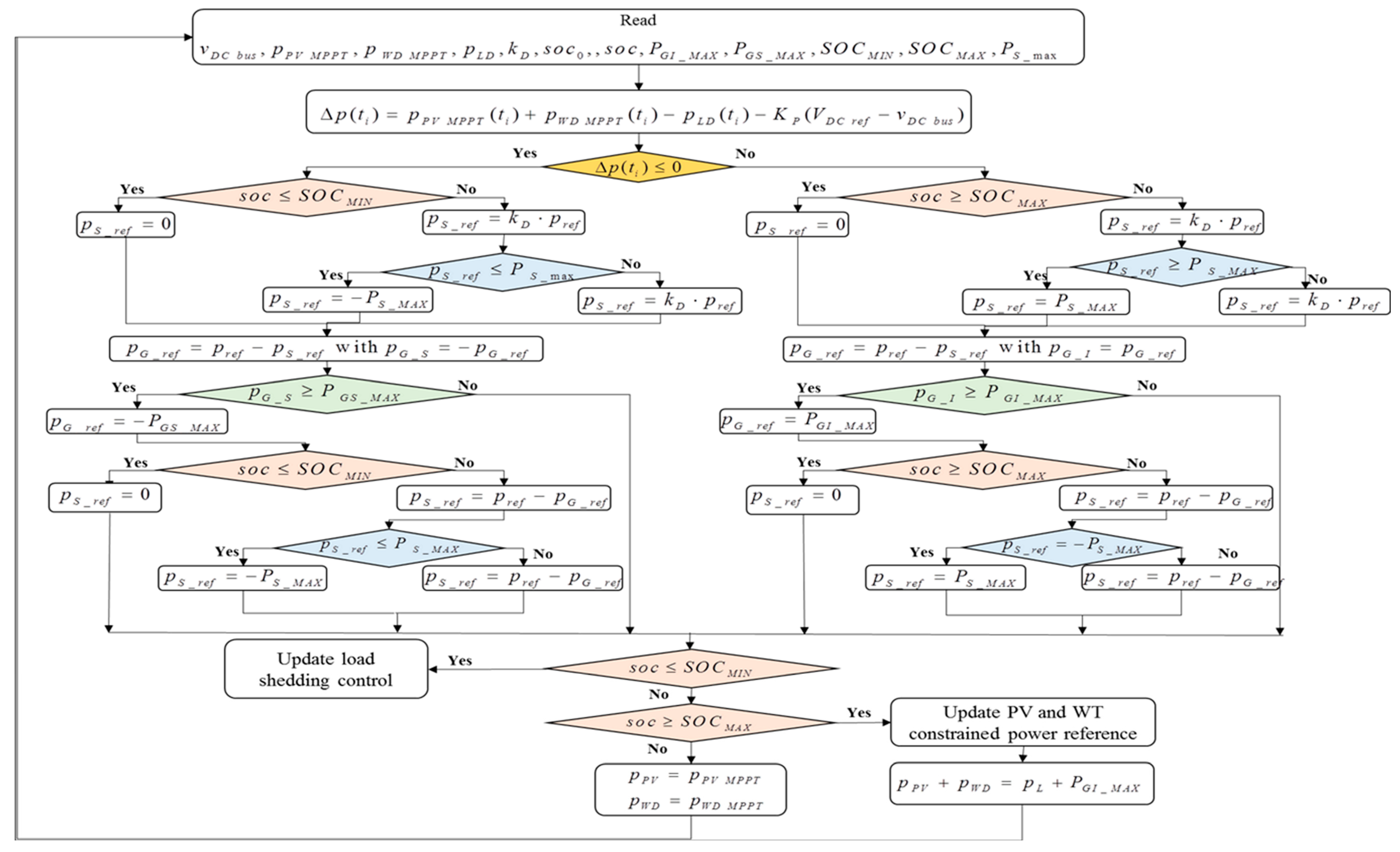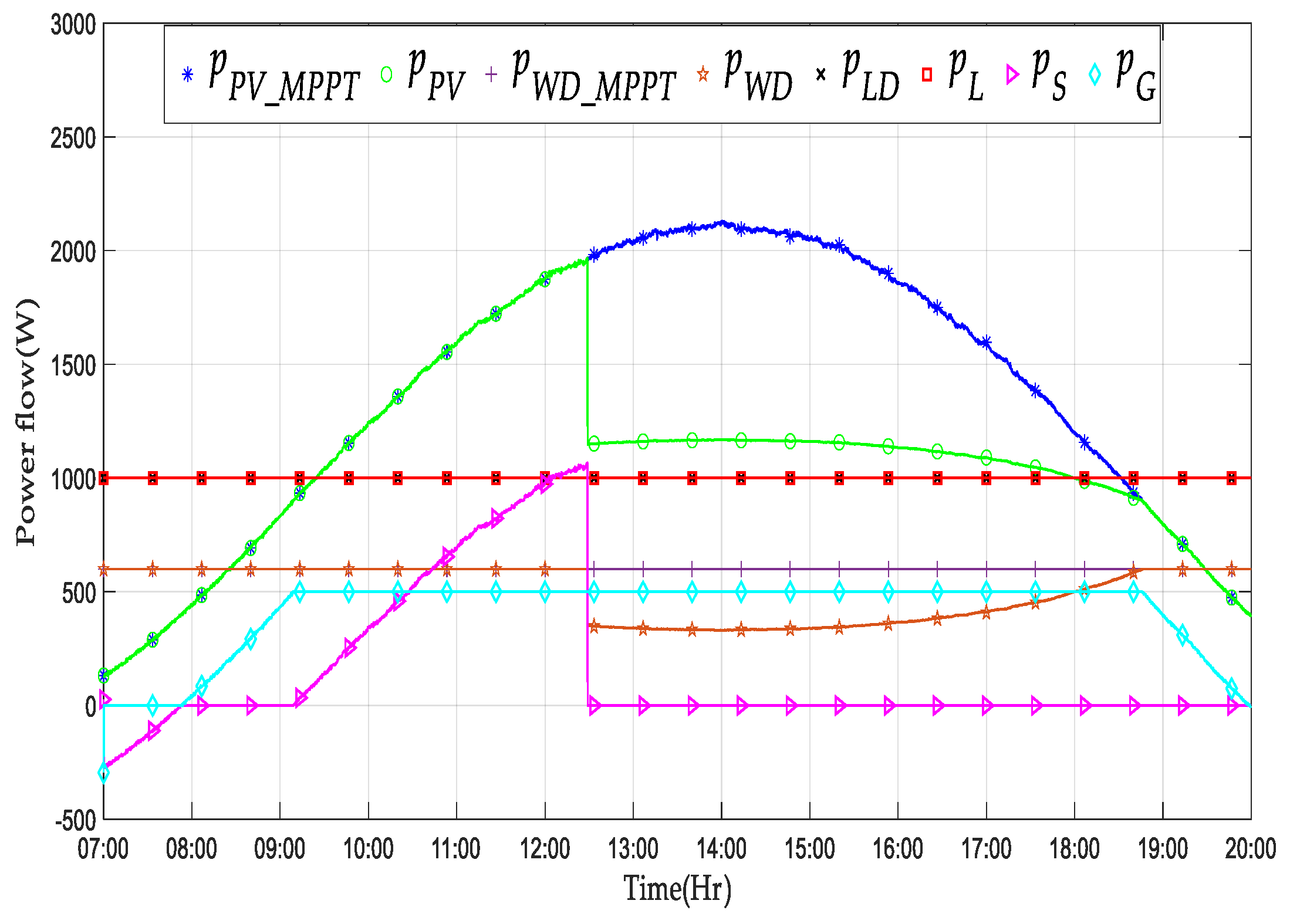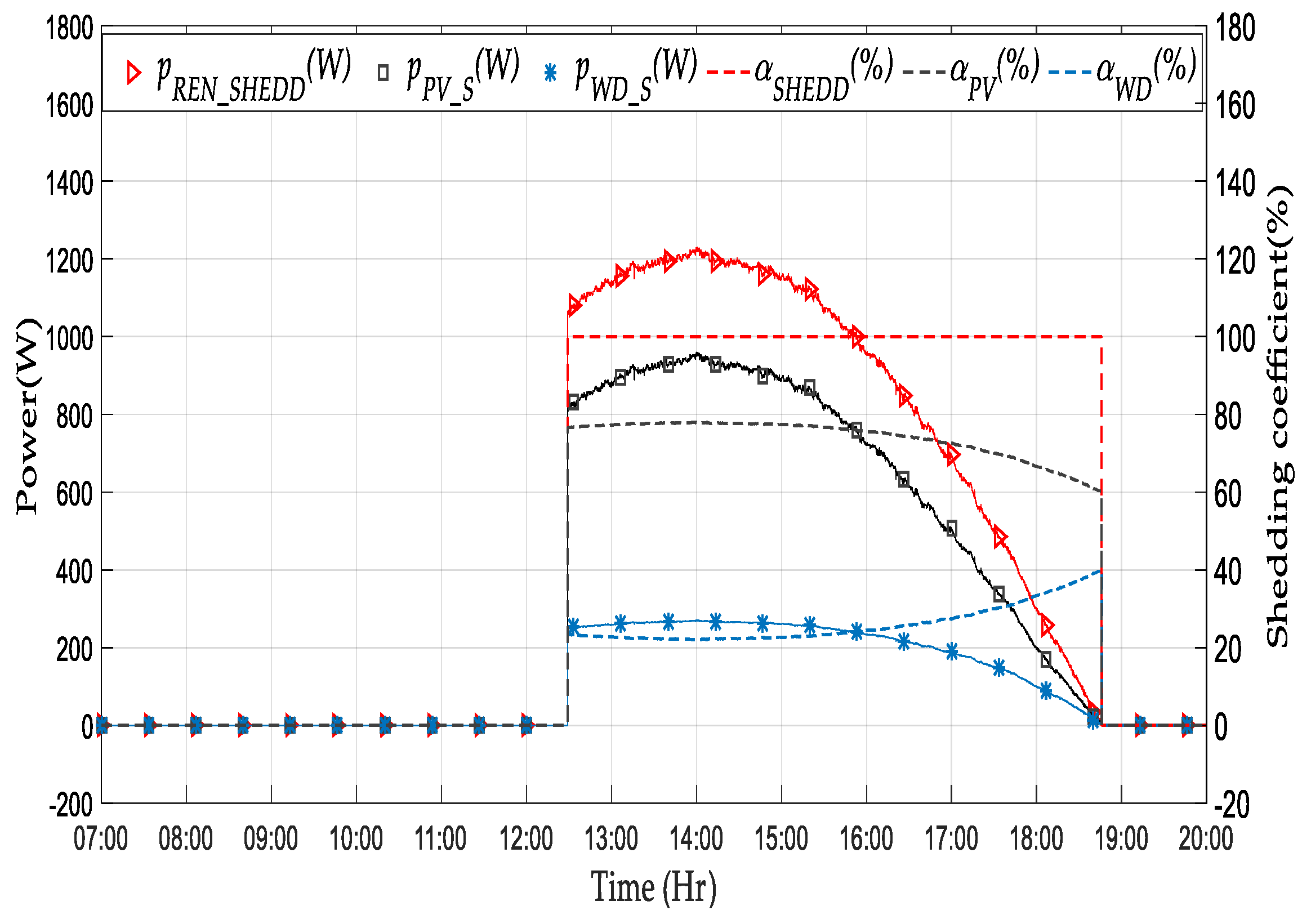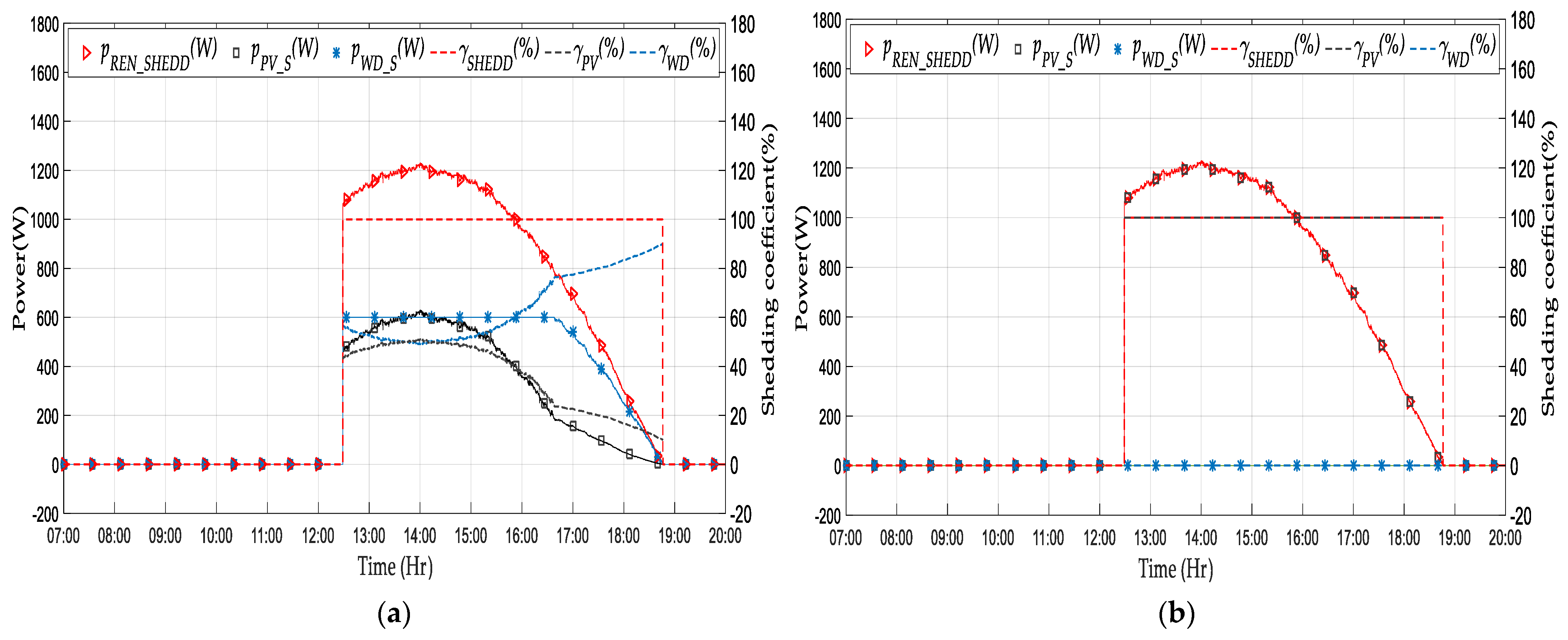1. Introduction
In recent years, providing energy by using fossil fuels has rapidly increased environmental pollution and global warming. In addition, a lack of pure and inexpensive energy persists due to the rising fuel cost and energy demand. In this context, renewable energy sources (RESs), such as photovoltaic panels (PV) and wind turbines (WTs), have been introduced and developed to partially solve issues related to energy. In addition, to increase power supply efficiency and save costs, distributed energy resources (DERs) based on RESs have also been proposed and studied. Nonetheless, increasing RESs power cannot be directly exploited or entirely stored due to intermittent power generation. This makes the management of the electrical network a critical issue. Therefore, the deployment of conventional and RESs alongside local loads in small-scale networks such as a MG is one of the newest aspects of electrical networks as well as a solution to solve the intermittency problem [
1].
MG can be described as an integrated power system that functions in a small power range compared to the public grid. This electrical structure offers many benefits, such as stability, independence, and flexibility. It also guarantees economic advantages by reducing costs owing to the liberalized electricity market and decentralized power management [
2]. Thanks to these MG characteristics, the power supply systems in the form of MG have been studied extensively in recent years. The research in the MG field has tackled different aspects such as power balance, and energy management by investigating defects and advantages [
3]. The main objectives of all these research works are related to the power flow distribution and the achievement of the lowest MG operating energy cost by keeping the power balance among every component, meeting load demand, and encouraging the use of RESs.
This article studies the impact of integrating a SSWD into a DC MG, including PV and which is connected to the grid. Three points are approached. First, an algorithm for both power control and power management for the studied DC MG considering the grid-connected mode is suggested. The constraints of all physical components of this MG have been taken into account. Second, in the case of an excess in power produced by PV panels and SSWD, two types of coefficients called “shedding coefficients” are proposed to calculate the amount of power that should be limited from each RES. Finally, two strategies for energy management, i.e., optimization and storage priority (without optimization), are considered during the simulation.
This article is organized as follows: a literature review about power and energy management is provided in
Section 2. The DC MG modeling is presented in
Section 3. The supervision overview, including power control and energy management, is described in
Section 4. Shedding coefficients are proposed and detailed in
Section 5. The performance of the proposed coefficients is verified using a simulation, and the results and analysis are discussed in
Section 6. The conclusions are given in
Section 7.
2. Literature Review
Researchers have made remarkable efforts to increase environmental protection to overcome the fast depletion of fossil fuels and the energy crisis. In this context, RESs have been deployed in the power system to meet the energy demand and respond to environmental issues. Thus, MGs have been introduced as a new electrical structure to combine DERs, energy storage systems (ESSs), and loads. However, despite the significant growth in the MG concept, its architectures and control system are still novel and under continuous development. Some problems, such as the intermittence of PV and WT power generation, the physical constraints related to the components, the uncertainty of the power prediction, the overall operating cost, etc., have to be considered while designing a MG. In this regard, a supervisory system, including a power and energy management system, is crucial for the optimal exploitation of DERs to ensure a secure, reliable, and intelligent system. It is based on the collection and communication of the information, a system for power prediction, an economic dispatch system, and the needs of the end-users. The main goal is to meet load demand at the lowest operating cost by managing the power flow in real-time, improving power quality, optimizing a long-term energy schedule, raising the use of renewable energy, and smoothing power fluctuations from RESs.
In a MG, economic dispatch optimization and power management systems are always considered to minimize power losses and simplify the control process. The energy management system (EMS) for a MG can be described as a multi-objective system that optimizes the economic dispatch, operation, energy scheduling, system reliability, and the global cost of the system for both grid-connected and islanded modes [
4]. Several studies in the literature suggest different energy management strategies to achieve an optimal and efficient operation of the MG. Many classifications may exist for the common methods used for the EMS. Strategies such as rule-based and optimization-based EMS have been suggested. Yet, a combination of different methods could be a practical solution for EMS. In general, EMS techniques can be classified into two major categories, i.e., classical and artificial intelligence methods.
The iterative non-deterministic algorithm is one of the classical methods used for executing the EMS. It can be utilized to realize several design objective functions, such as the single objective optimization or the multi-objective optimization, which can be optimized. If a single objective optimization approach was adopted by the designer, it means that a single objective is optimized during the process of the optimization and can also be extended to many non-conflicting objectives. However, once multiple, conflicting objectives need to be optimized simultaneously, single-objective optimization deteriorates some objectives to achieve only one. In such a case, multi-objective optimization makes a trade-off and provides the best values for all objectives. Many works using iterative algorithms for the exploitation of RESs can be found in the literature [
5,
6]. Most studies investigating deterministic optimization in the literature employ a forecasting algorithm to predict future energy pricing, load profile, and power generation from RESs. The authors of [
7] proposed an optimization technique based on linear programming for sizing and simulating a stand-alone hybrid PV-WT-battery storage system located in rural areas in favor of reducing the total cost by measuring power supply probability losses. Mixed-integer linear programming is another deterministic method that has been used by several authors for MG EMS. It takes advantage of its ability to use integer and binary variables to decide on the operating system. In [
8], researchers highlighted and designed an EMS model through a mixed-integer linear programming optimization for a residential MG system. The conclusion placed the batteries as an uncompetitive element in the case of residential applications because of their high investment and replacement cost in the residential market. Many authors have suggested stochastic economic dispatch techniques to address constrained optimization with uncertainty in the MG system. The MG is characterized by an increasing number of variable and volatile generation sources under fluctuating energy markets. A two-stage stochastic optimization model was presented by several authors. The authors of [
9] presented an optimization built on two stages for the MG operation, with consideration of load demand and uncertainties of RESs. The first stage performs the optimization based on the investment cost of the MG and the second stage attempts to address the energy management operation of the MG. Although many stochastic methods perform favorably compared to deterministic approaches, their solutions still require a high level of complexity in the formulation.
Several recent studies have focused on utilizing artificial intelligence methods for performing the EMS for the MGs. These approaches could be applied to solve both single-objective optimization and multi-objective optimization problems. First, the fuzzy logic technique is an artificial method commonly used for EMS in both grid-connected and stand-alone energy systems. Researchers in [
10] enumerated the advantages of the fuzzy logic-based EMS over other methods by comparing the response capability and the ease of adaption to sudden changes during the period of operation. Second, the neural network (NN) is another intelligent approach widely used for control and energy management in MG systems. It is able to handle complex-nonlinear systems in a reliable way. The control strategy is based on a NN approach and results showed that this strategy can keep the voltage stable and continuous during the maximum use of RESs, which can satisfy consumers’ electricity needs. Finally, evolutionary algorithms, inspired initially by biological evolution, constitute another subfield of artificial intelligence. The genetic algorithm is one of the popular algorithms in this category. In several studies [
11,
12], a genetic algorithm was used thanks to its powerful optimization capacity. An interesting study was conducted in [
11] where authors applied a genetic algorithm in four different residential zones in India for an optimal sizing of RESs associated with ESS. Results showed that a combination of PV, WT, and battery storage guarantees the most cost-effective solution for residential applications.
Therefore for control purposes, it is necessary that an EMS has a connection with a power management strategy within a MG to achieve the goals of the supervision. The power in a MG should be well distributed to keep the power balanced among every component. For this purpose, power management, including source, storage, and load management, should be considered. The intermittency related to the power generated by RESs makes its usage and control necessary and more difficult. Thus, the authors of [
13] suggested a control and power management system for PV-battery-based hybrid MGs to regulate the DC and AC bus voltages and frequency under different operating circumstances. Yet, the battery here is considered limited in terms of capacity, charging, and discharging current. Then, the public grid is presented as an important power exchange interface to complete the battery functions and provide a low-cost operation. In [
14], the authors proposed a new control algorithm for effective power management in DC MG with RESs and ESS. The purpose is to overcome the average power-sharing and bus voltage regulation problems and maximize the utilization of the source power. The control scheme treats the additional power available beyond its average rated value as a virtual generation. Thus, new references are generated considering virtual generation. This proposed algorithm allows using the virtual generation in the operation to reduce the charging/discharging cycles of ESS. Hence, it increases the life span of the ESS, reduces power fluctuations, and regulates the system bus voltage. In [
15], a distributed robust energy management scheme for multiple interconnected MGs was developed. It aims to optimize the total operational cost of the MGs through energy trading with neighboring MGs and the main grid in the real-time energy market. To remain consistent with the distributed nature of the multiple MGs, a distributed adjustable robust optimal scheduling algorithm was suggested. Each MG energy management system determines its own selling price and operation schedule via distributed communication of noncritical information with its neighboring MGs. Robust optimal scheduling and fair energy trading can be collectively achieved.
It is crucial to underline that the use of two intermittent sources of different natures in both power management and optimization of a MG is little discussed and treated in literature. Indeed, in most of the studies, the two renewable sources are considered as a single source and their production is totally consumed by the MG. However, a surplus of production will require a separation of the two sources by taking into account energy and financial criteria.
4. MG Supervision Overview
The proposed multi-layer supervisory system (
Figure 2) [
23] is structured into four main layers that interact among themselves and operate in at different scale times. The aim of the MG supervisory is to interact with the smart grid (SG) and the end-user. It is able to receive metadata from external sources, and keep the instantaneous power balance in the MG. Several works carried out in the Avenues unit research have been based on this structure [
24,
25]. Parameters refer to a group of parameters related to the MG and their physical limitations. The metadata receives the forecast data. The SG is responsible for exchanging messages and communication with the public grid. Characteristics of each layer have been explained in detail in [
20].
4.1. Energy Management
The energy management layer aims to optimize and minimize the total energy cost by dispatching power flow according to the power prediction, SG messages, and measurement data under the constraints of the modeling. In this section, optimization for a grid-connected mode is studied.
Mixed-integer linear programming was chosen as a solver for the formulated problem, and the optimization was performed day-ahead by using prediction data. The optimization results were the power flows of sources and load translated into a distribution coefficient. This latter is regarded as a predictive control variable responsible for communication with the operational layer to ensure an optimal operation.
The proposed problem formulation was based on the components characteristics and constraints already presented in Equations (2)–(12). The stability of the DC bus voltage was then ensured by the power balance constraint presented in Equation (13). The controller dynamic considered for the MG was not used in this study.
The total energy cost result of the optimization is expressed in Equation (14):
where
is the PV shedding energy cost,
is the SSWD shedding energy cost,
is the load shedding energy cost, and
is the storage energy cost,
is the public grid energy cost.
The tariffs
and
are calculated in Equations (15) and (16) according to the amount of PV and SSWD shedding power.
The cost of load shedding is defined in Equation (17), and it introduces inconvenience for end-users:
The grid cost is defined in Equation (18), and it shows that the grid power could be bought or sold at the same price.
where
and
are, respectively, the power grid and supply.
This study took into consideration a single rate for energy purchased or sold and the grid energy tariff was defined according to peak hour () or normal hour ().
The storage cost is provided in Equation (19), and it is based on storage aging:
where
and
are, respectively, the storage power charge and discharge.
The optimization under constraints were formulated as follow:
Minimize:
with respect to:
All these constraints have been explained in
Section 3. The three constraints preceded by “if” show that no load shedding power is allowed when the load can be fully supplied, while no PV and SSWD shedding power can occur when the PV and SSWD power can be fully consumed. Moreover, neither load shedding nor RESs power shedding can happen when there is no production from PV and SSWD.
Additional constraints showing that the storage and the grid cannot directly exchange power are given in Equation (22):
The coefficient
is given to introduce the day-ahead optimization results into the power management layer and to decouple the system operation between the power management layer and the energy management layer. It was calculated according to (23):
where
is the power distribution rate between storage and public grid.
4.2. Power Management
The power management is performed in the operational layer that is responsible for keeping the instant power balance and ensuring the DC bus voltage stabilization concerning the system’s constraints and physical limits. The applied algorithm started first by reading the fixed parameters, the real measurements, and the updated parameter value provided from the optimization. Second, the compensation power was calculated according to Equation (1). Using the resulting power and the distribution parameter, the power that should be exchanged with the public grid and the storage was calculated to ensure power balance and voltage stability. The suggested power management strategy is a rule-based method is presented in the flow chart given in
Figure 3.
The is calculated in the energy management and introduced in the real-time power management strategy. As illustrated in the flow chart, the storage reference is updated two times: the first one is for power balancing before that the grid reaches its limits. Once this latter occurs a second update of the storage reference happens to perform load shedding or PV and SSWD constrained production.
Furthermore, the proposed power management strategy consists of two extreme cases: (i) if there is a shortage of energy for supplying the load, which means that when PV panels and SSWD produce insufficient power, the grid reaches its limit, and the storage is empty. It this case, load shedding happens; (ii) if the PV panels and SSWD power production cannot be totally consumed, which means that the grid reaches its injection limit, the storage achieves the upper limit, and the load is fully supplied or cannot consume enough, the PV and SSWD energy should be limited.
To separate and calculate the power which must be limited from each source, two coefficients called “shedding coefficients” have been proposed. The idea is to first calculate the total power, which must be shed from the two sources, and multiply it respectively by the shedding coefficients in order to define the power, which must be shed by each source.
7. Conclusions
The integration of a SSWD into a DC MG connected to the grid requires a deep understanding of many parameters, including factors related to energy and power management. In this article, the supervision control design was described. In this context, a strategy for optimizing the MG that permits transactions with the main distribution network and the participation of the end-user customers has been suggested. The optimization and minimization of the total operating cost were investigated by dispatching power flow according to the power profiles and measurement data under the constraints of the modeling. Indeed, in the case of the power excess produced by PV sources and the SSWD, it is crucial to perform the power limitation to ensure power balancing, which is the main goal of the supervision. For that, two approaches were suggested:
The first one was based on applying a shedding coefficient called that was based on limiting power depending on the percentage of contribution of each source in generating the excess of power. This coefficient was performed in two different cases: storage priority and optimization.
The second one was about using a second shedding coefficient called This latter principle was limiting the excess of power by taking into account not only the production of each RESs but also the shedding cost related to each source. This coefficient was tested in scenarios with and without optimization.
The results highlighted that the coefficient provides good performances in terms of the cost compared to since the coefficient takes into account the RESs’ tariff in the case of renewable power shedding. In addition, the results also revealed that whatever the scenario used, the simulation with optimization conditions leads to reduce the costs compared to the simulation without optimization. The optimization permits minimizing the cost by favoring the exchange of power between the public grid and the storage (selling power to the grid). This study showed the importance of the optimization method and the impact of the shedding coefficients in obtaining the best energy performances with the lowest cost. Moreover, the optimization gave better energy performance while minimizing PV and SSWD power shedding.
To conclude, simulation results showed that the supervision control can maintain power balancing while performing optimized control, even by using an arbitrary power profile and arbitrary energy tariffs. The optimized power control handles several constraints, such as storage and grid power limitations.
Further work will focus on experimental validation of the studied DC MG by taking into account the dynamic efficiency of the converters and real-life random trends. The supervisory system should be also improved to be able to manage and decrease power losses in the converters and contribute to the stabilization of the bus voltage.
























